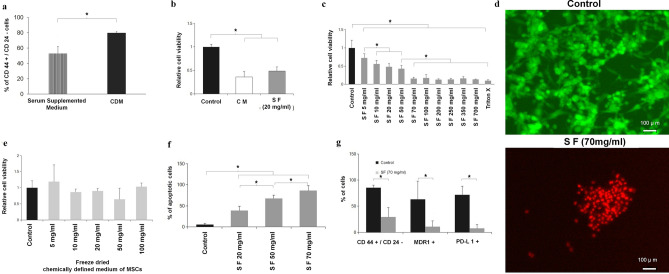Figure 2.
Adipose derived stem cell secretome on TNBC viability, apoptosis and molecular markers. (a) Flow cytometry results of TNBCs in serum supplemented medium and chemically defined medium with CD44+/CD24− breast cancer stem cell phenotype after 48 h. The chemically defined medium increased marker concentration because of the presence of insulin, hydrocortisone and epidermal growth factor that are known to contribute to colony formation characteristic feature of cancer stem cells51. (b) Graphical plot of cell viability comparison between control (medium without MSC exposure), MSC conditioned medium (without lyophilization), and SF. SF at the low concentration of 20 mg/ml is equivalent to the MSC conditioned media results. (c) Dose dependent effect of SF on TNBC viability at 5, 10, 20, 50, 70, 100, 200, 250, 350 and 700 mg/ml. Above a dose of 50 mg/ml SF has substantial cell kill. (d) Effect of secretome free media showing that lyophilization of the media alone does not affect cell viability. Green color shows calcein binding to actin filaments in live cells. (e) Fluorescence image of live dead staining of TNBCs treated with 70 mg/ml SF for 48 h showing cell kill. Red color shows ethidium homodimer binding to nucleic acid in dead cells. (f) Apoptosis of cells treated with varying concentrations of SF for 48 h evaluated by Annexin-V–PI staining using flow cytometry showing an increase in cancer cell apoptosis. (g) Histogram of flow cytometry results showing the effect of 70 mg/ml SF on CD44+/CD24− breast cancer stem cells (CSCs), multi drug resistance protein 1 (MDR1) and programmed death ligand-1(PD-L1) expressing cells. All markers are substantially decreased by SF. See text for discussion. All graphical plots are mean ± SD values and differences between control and treatment concentrations were considered statistically significant for p value < 0.05 and is represented by (*).

